Particle filter injector RENAULT SCENIC 2011 J95 / 3.G Engine And Peripherals Siemens Injection Workshop Manual
[x] Cancel search | Manufacturer: RENAULT, Model Year: 2011, Model line: SCENIC, Model: RENAULT SCENIC 2011 J95 / 3.GPages: 329, PDF Size: 1.71 MB
Page 7 of 329
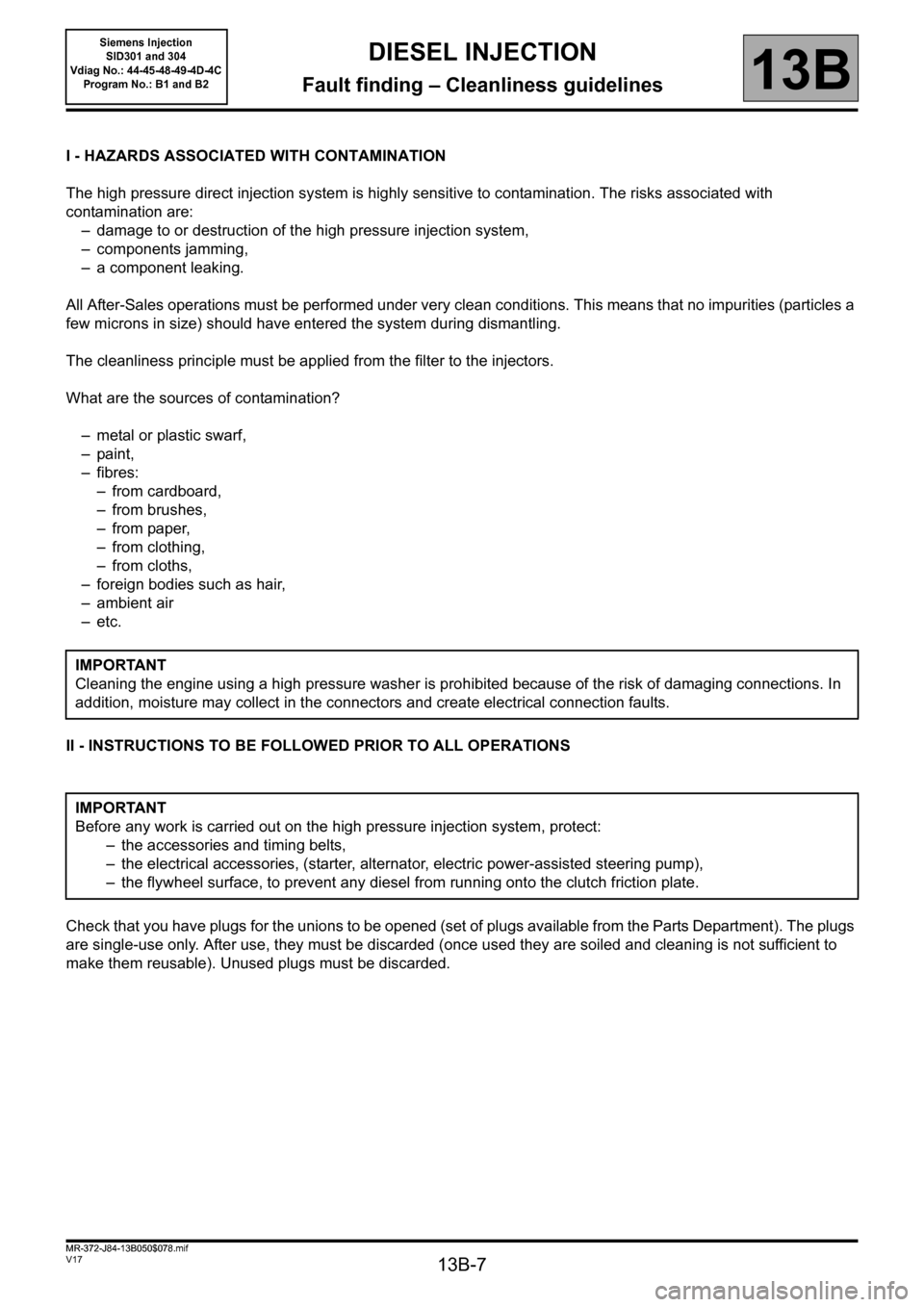
13B-7
MR-372-J84-13B050$078.mif
V17
13B
DIESEL INJECTION
Fault finding – Cleanliness guidelines
I - HAZARDS ASSOCIATED WITH CONTAMINATION
The high pressure direct injection system is highly sensitive to contamination. The risks associated with
contamination are:
– damage to or destruction of the high pressure injection system,
– components jamming,
– a component leaking.
All After-Sales operations must be performed under very clean conditions. This means that no impurities (particles a
few microns in size) should have entered the system during dismantling.
The cleanliness principle must be applied from the filter to the injectors.
What are the sources of contamination?
– metal or plastic swarf,
– paint,
–fibres:
– from cardboard,
– from brushes,
– from paper,
– from clothing,
– from cloths,
– foreign bodies such as hair,
–ambient air
–etc.
II - INSTRUCTIONS TO BE FOLLOWED PRIOR TO ALL OPERATIONS
Check that you have plugs for the unions to be opened (set of plugs available from the Parts Department). The plugs
are single-use only. After use, they must be discarded (once used they are soiled and cleaning is not sufficient to
make them reusable). Unused plugs must be discarded.IMPORTANT
Cleaning the engine using a high pressure washer is prohibited because of the risk of damaging connections. In
addition, moisture may collect in the connectors and create electrical connection faults.
IMPORTANT
Before any work is carried out on the high pressure injection system, protect:
– the accessories and timing belts,
– the electrical accessories, (starter, alternator, electric power-assisted steering pump),
– the flywheel surface, to prevent any diesel from running onto the clutch friction plate.
MR-372-J84-13B050$078.mif
Siemens Injection
SID301 and 304
Vdiag No.: 44-45-48-49-4D-4C
Program No.: B1 and B2
Page 9 of 329
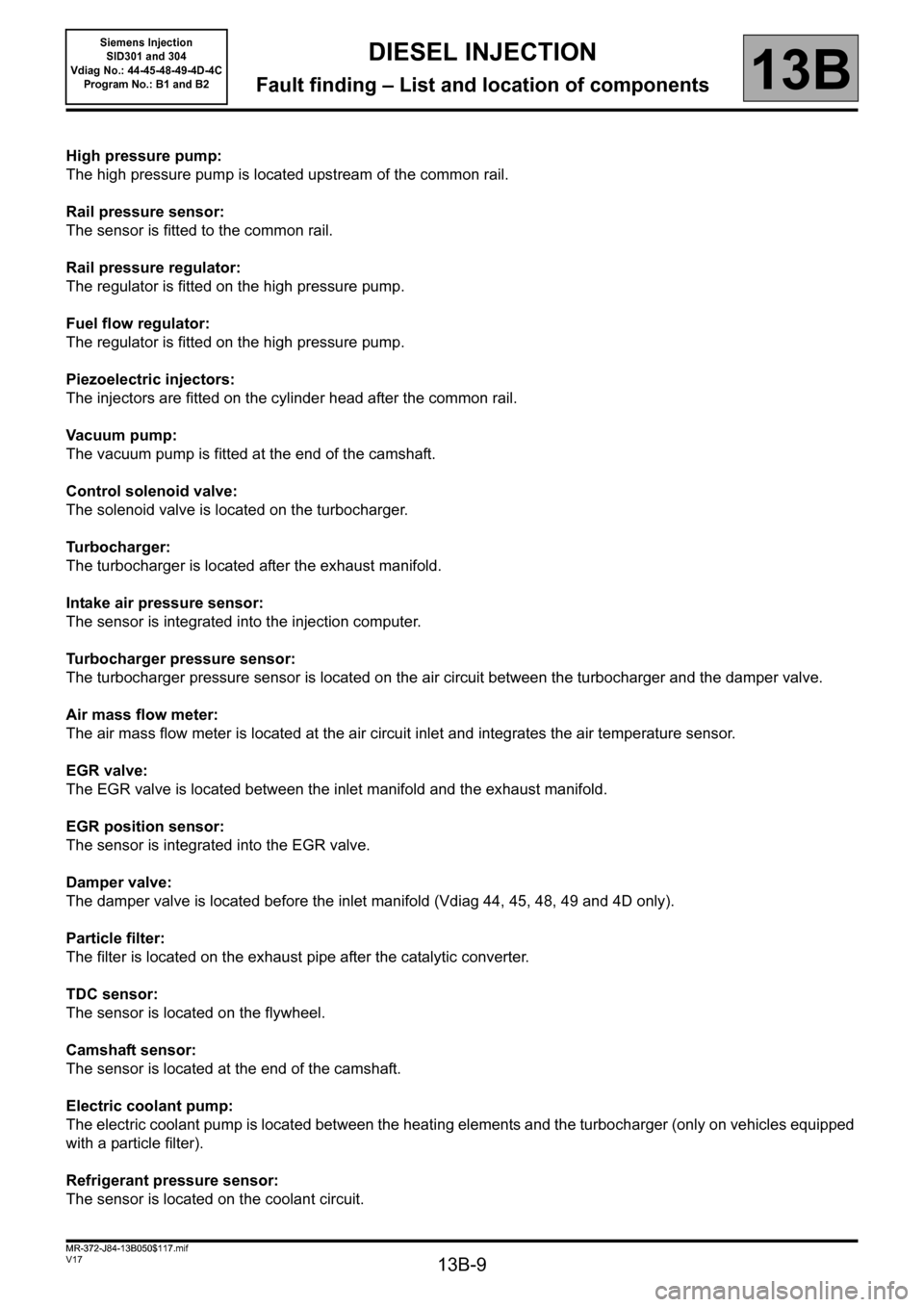
13B-9
MR-372-J84-13B050$117.mif
V17
13B
DIESEL INJECTION
Fault finding – List and location of components
High pressure pump:
The high pressure pump is located upstream of the common rail.
Rail pressure sensor:
The sensor is fitted to the common rail.
Rail pressure regulator:
The regulator is fitted on the high pressure pump.
Fuel flow regulator:
The regulator is fitted on the high pressure pump.
Piezoelectric injectors:
The injectors are fitted on the cylinder head after the common rail.
Vacuum pump:
The vacuum pump is fitted at the end of the camshaft.
Control solenoid valve:
The solenoid valve is located on the turbocharger.
Turbocharger:
The turbocharger is located after the exhaust manifold.
Intake air pressure sensor:
The sensor is integrated into the injection computer.
Turbocharger pressure sensor:
The turbocharger pressure sensor is located on the air circuit between the turbocharger and the damper valve.
Air mass flow meter:
The air mass flow meter is located at the air circuit inlet and integrates the air temperature sensor.
EGR valve:
The EGR valve is located between the inlet manifold and the exhaust manifold.
EGR position sensor:
The sensor is integrated into the EGR valve.
Damper valve:
The damper valve is located before the inlet manifold (Vdiag 44, 45, 48, 49 and 4D only).
Particle filter:
The filter is located on the exhaust pipe after the catalytic converter.
TDC sensor:
The sensor is located on the flywheel.
Camshaft sensor:
The sensor is located at the end of the camshaft.
Electric coolant pump:
The electric coolant pump is located between the heating elements and the turbocharger (only on vehicles equipped
with a particle filter).
Refrigerant pressure sensor:
The sensor is located on the coolant circuit.
MR-372-J84-13B050$117.mif
Siemens Injection
SID301 and 304
Vdiag No.: 44-45-48-49-4D-4C
Program No.: B1 and B2
Page 10 of 329

13B-10
MR-372-J84-13B050$117.mif
V17
Siemens Injection
SID301 and 304
Vdiag No.: 44-45-48-49-4D-4C
Program No.: B1 and B2DIESEL INJECTION
Fault finding – List and location of components13B
Heating elements:
The heating elements are located in the cooling circuit before the additional coolant pump which cools the
turbocharger (Vdiag 45, 49 and 4D only).
Coolant temperature sensor:
The sensor is located on the cylinder head near the engine water chamber.
Air temperature sensor:
The air temperature sensor is located at the air circuit inlet, integrated into the air flowmeter.
Turbocharging pressure sensor solenoid valve:
The solenoid valve is located on the turbocharger.
Catalytic converter:
The catalytic converter is located upstream of the exhaust system and downstream of the turbocharger.
Fuel temperature sensor:
The sensor is located near the injection pump and injector return.
Catalytic converter downstream temperature sensor:
The sensor is located after the catalytic converter.
Turbine upstream temperature sensor:
This sensor is located between the exhaust pipe and the turbocharger.
Cruise control/speed limiter on/off switch:
This switch is located in the passenger compartment to the left of the steering wheel near the lighting dimmer.
Water in diesel fuel sensor (optional):
This sensor is located in the diesel filter.
Fan unit relay:
The relay is located on the cooling radiator.
Accelerator potentiometer:
The potentiometer is located on the accelerator pedal.
Brake pedal switch:
The switch is located on the brake pedal.
Clutch pedal switch:
The switch is located on the clutch pedal.
Heater plugs:
The heater plugs are located on the cylinder head.
Particle filter injector:
The injector is located between the particle filter injector fuel pump and the exhaust pipe. (Vdiag 45, 49 and 4D only)
Electric fuel pump:
The pump is located between the tank and the particle filter injector fuel filter. (Vdiag 45, 49 and 4D only)
Page 12 of 329

13B-12
MR-372-J84-13B050$156.mif
V17
13B
DIESEL INJECTION
Fault finding – Operating diagram
1 Flowmeter
2 Air temperature sensor (integrated into the
flowmeter)
3 Turbocharging pressure sensor
4 Air flap
5 Direct current EGR valve
6 Variable geometry turbocharger solenoid
valve (VGT)
7 Flow regulator
8 Pressure regulator
9 Rail pressure sensor
10 Fuel temperature sensor
11 Heater plugs
12 Coolant temperature sensor
13 TDC sensor
14 Camshaft sensor
15 Atmospheric pressure sensor16 Freon pressure sensor
17 Accelerator pedal
18 Clutch switch
19 Brake switch
20 Turbine upstream temperature sensor
21 Catalytic converter downstream temperature sensor
22 Particle filter upstream temperature sensor (SID 304)
23 Particle filter downstream temperature sensor (SID 304)
24 Particle filter differential pressure sensor (SID 304)
25 Particle filter injector fuel pump (SID 304)
26 Particle filter injector (SID 304)
27 Electric coolant pump (SID 304)
28 Heating elements (SID 304)
29 Multiplex line network (multiplexing)
30 Water in diesel fuel sensor (optional)
MR-372-J84-13B050$156.mif
Siemens Injection
SID301 and 304
Vdiag No.: 44-45-48-49-4D-4C
Program No.: B1 and B2
Page 13 of 329
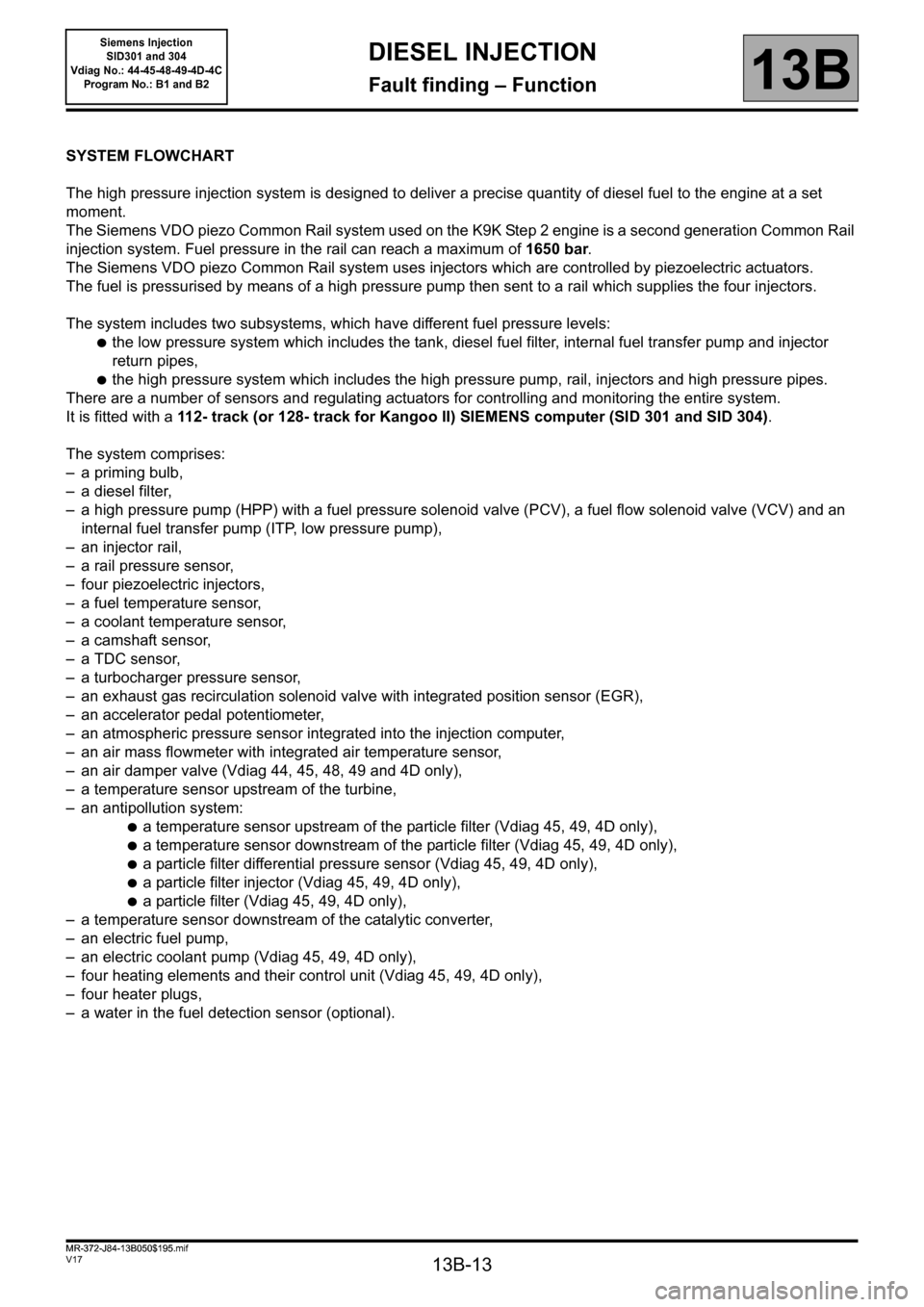
13B-13
MR-372-J84-13B050$195.mif
V17
13B
DIESEL INJECTION
Fault finding – Function
SYSTEM FLOWCHART
The high pressure injection system is designed to deliver a precise quantity of diesel fuel to the engine at a set
moment.
The Siemens VDO piezo Common Rail system used on the K9K Step 2 engine is a second generation Common Rail
injection system. Fuel pressure in the rail can reach a maximum of 1650 bar.
The Siemens VDO piezo Common Rail system uses injectors which are controlled by piezoelectric actuators.
The fuel is pressurised by means of a high pressure pump then sent to a rail which supplies the four injectors.
The system includes two subsystems, which have different fuel pressure levels:
●the low pressure system which includes the tank, diesel fuel filter, internal fuel transfer pump and injector
return pipes,
●the high pressure system which includes the high pressure pump, rail, injectors and high pressure pipes.
There are a number of sensors and regulating actuators for controlling and monitoring the entire system.
It is fitted with a 112- track (or 128- track for Kangoo II) SIEMENS computer (SID 301 and SID 304).
The system comprises:
– a priming bulb,
– a diesel filter,
– a high pressure pump (HPP) with a fuel pressure solenoid valve (PCV), a fuel flow solenoid valve (VCV) and an
internal fuel transfer pump (ITP, low pressure pump),
– an injector rail,
– a rail pressure sensor,
– four piezoelectric injectors,
– a fuel temperature sensor,
– a coolant temperature sensor,
– a camshaft sensor,
– a TDC sensor,
– a turbocharger pressure sensor,
– an exhaust gas recirculation solenoid valve with integrated position sensor (EGR),
– an accelerator pedal potentiometer,
– an atmospheric pressure sensor integrated into the injection computer,
– an air mass flowmeter with integrated air temperature sensor,
– an air damper valve (Vdiag 44, 45, 48, 49 and 4D only),
– a temperature sensor upstream of the turbine,
– an antipollution system:
●a temperature sensor upstream of the particle filter (Vdiag 45, 49, 4D only),
●a temperature sensor downstream of the particle filter (Vdiag 45, 49, 4D only),
●a particle filter differential pressure sensor (Vdiag 45, 49, 4D only),
●a particle filter injector (Vdiag 45, 49, 4D only),
●a particle filter (Vdiag 45, 49, 4D only),
– a temperature sensor downstream of the catalytic converter,
– an electric fuel pump,
– an electric coolant pump (Vdiag 45, 49, 4D only),
– four heating elements and their control unit (Vdiag 45, 49, 4D only),
– four heater plugs,
– a water in the fuel detection sensor (optional).
MR-372-J84-13B050$195.mif
Siemens Injection
SID301 and 304
Vdiag No.: 44-45-48-49-4D-4C
Program No.: B1 and B2
Page 19 of 329
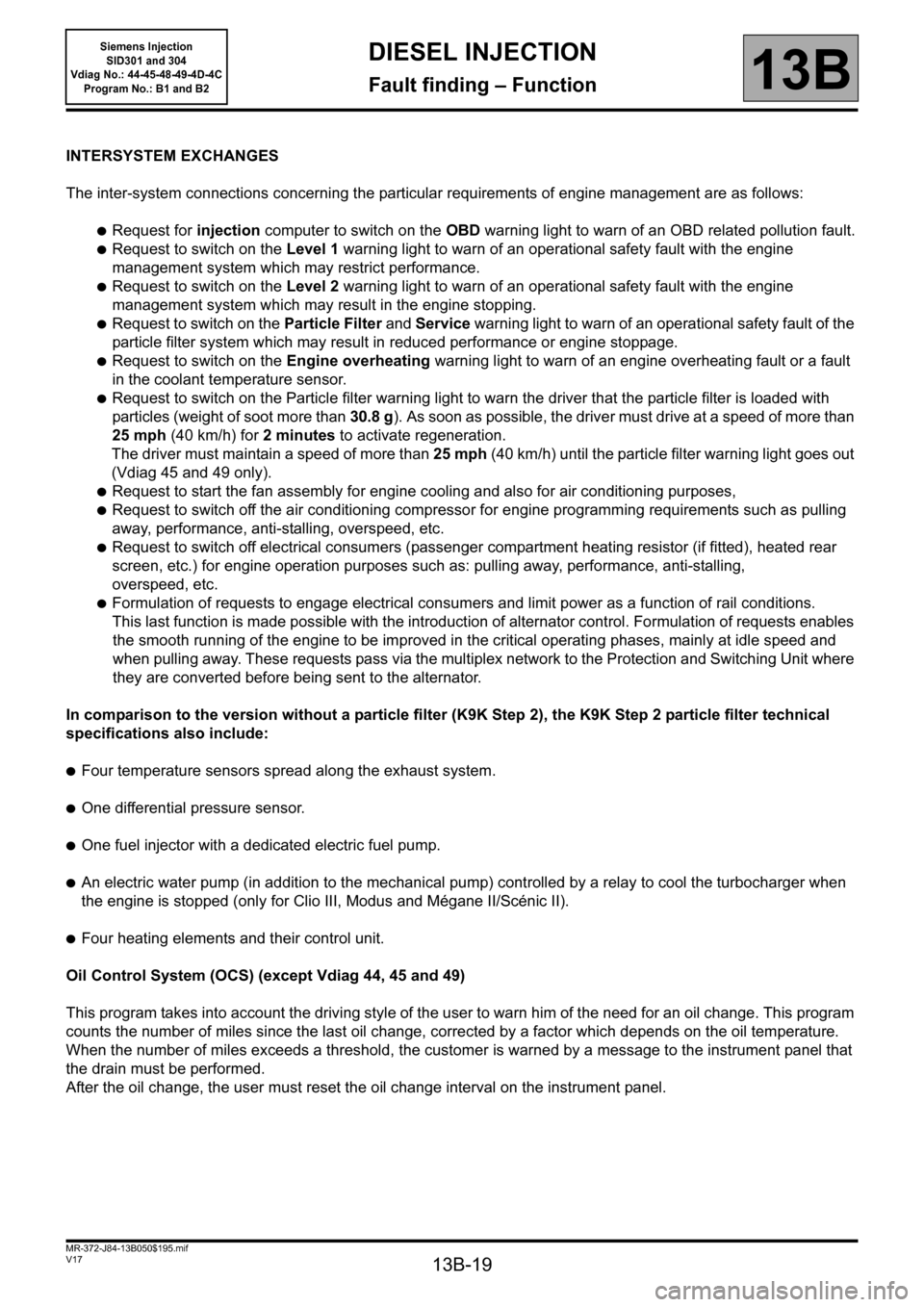
13B-19
MR-372-J84-13B050$195.mif
V17
Siemens Injection
SID301 and 304
Vdiag No.: 44-45-48-49-4D-4C
Program No.: B1 and B2DIESEL INJECTION
Fault finding – Function13B
INTERSYSTEM EXCHANGES
The inter-system connections concerning the particular requirements of engine management are as follows:
●Request for injection computer to switch on the OBD warning light to warn of an OBD related pollution fault.
●Request to switch on the Level 1 warning light to warn of an operational safety fault with the engine
management system which may restrict performance.
●Request to switch on the Level 2 warning light to warn of an operational safety fault with the engine
management system which may result in the engine stopping.
●Request to switch on the Particle Filter and Service warning light to warn of an operational safety fault of the
particle filter system which may result in reduced performance or engine stoppage.
●Request to switch on the Engine overheating warning light to warn of an engine overheating fault or a fault
in the coolant temperature sensor.
●Request to switch on the Particle filter warning light to warn the driver that the particle filter is loaded with
particles (weight of soot more than 30.8 g). As soon as possible, the driver must drive at a speed of more than
25 mph (40 km/h) for 2 minutes to activate regeneration.
The driver must maintain a speed of more than 25 mph (40 km/h) until the particle filter warning light goes out
(Vdiag 45 and 49 only).
●Request to start the fan assembly for engine cooling and also for air conditioning purposes,
●Request to switch off the air conditioning compressor for engine programming requirements such as pulling
away, performance, anti-stalling, overspeed, etc.
●Request to switch off electrical consumers (passenger compartment heating resistor (if fitted), heated rear
screen, etc.) for engine operation purposes such as: pulling away, performance, anti-stalling,
overspeed, etc.
●Formulation of requests to engage electrical consumers and limit power as a function of rail conditions.
This last function is made possible with the introduction of alternator control. Formulation of requests enables
the smooth running of the engine to be improved in the critical operating phases, mainly at idle speed and
when pulling away. These requests pass via the multiplex network to the Protection and Switching Unit where
they are converted before being sent to the alternator.
In comparison to the version without a particle filter (K9K Step 2), the K9K Step 2 particle filter technical
specifications also include:
●Four temperature sensors spread along the exhaust system.
●One differential pressure sensor.
●One fuel injector with a dedicated electric fuel pump.
●An electric water pump (in addition to the mechanical pump) controlled by a relay to cool the turbocharger when
the engine is stopped (only for Clio III, Modus and Mégane II/Scénic II).
●Four heating elements and their control unit.
Oil Control System (OCS) (except Vdiag 44, 45 and 49)
This program takes into account the driving style of the user to warn him of the need for an oil change. This program
counts the number of miles since the last oil change, corrected by a factor which depends on the oil temperature.
When the number of miles exceeds a threshold, the customer is warned by a message to the instrument panel that
the drain must be performed.
After the oil change, the user must reset the oil change interval on the instrument panel.
Page 20 of 329
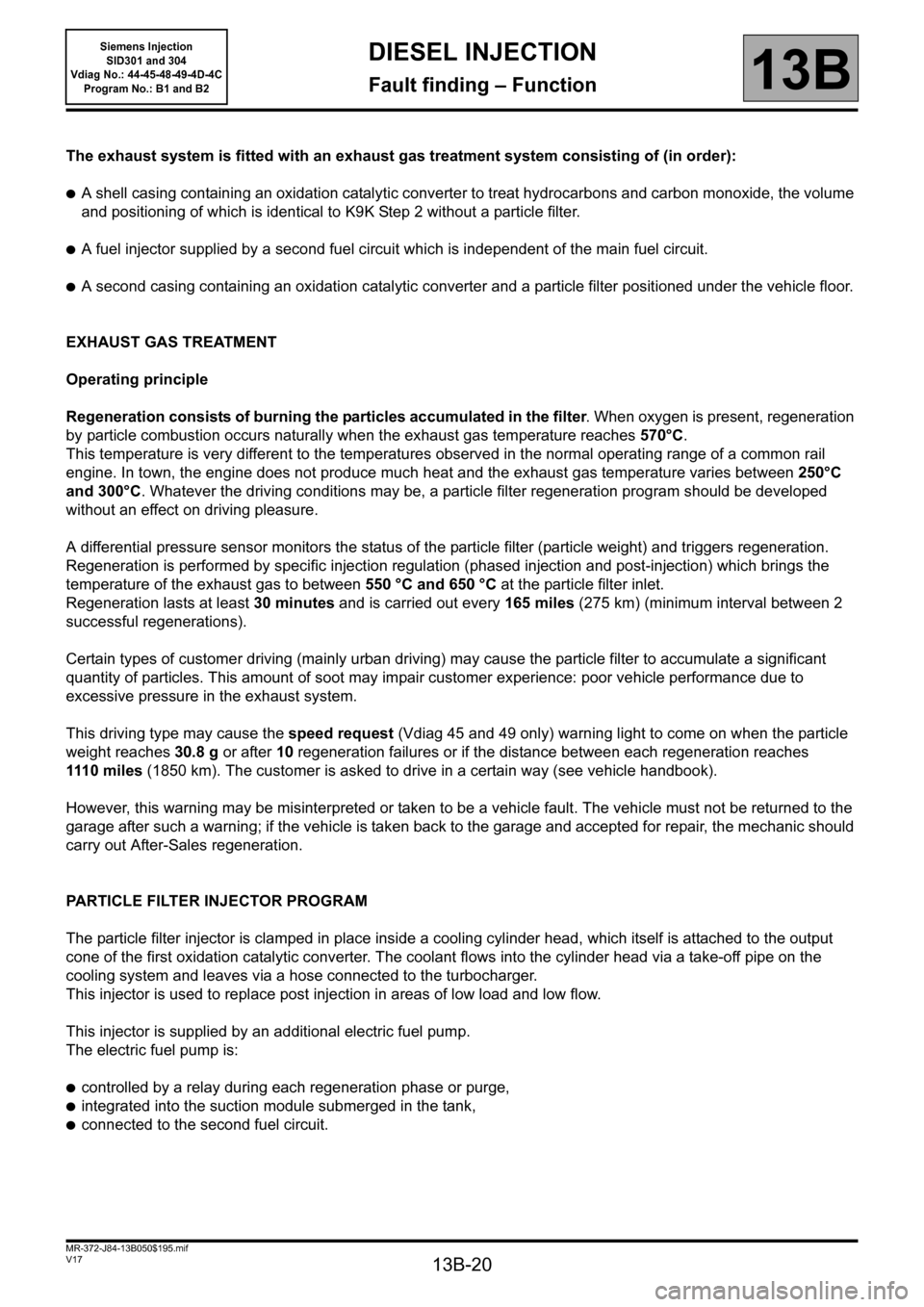
13B-20
MR-372-J84-13B050$195.mif
V17
Siemens Injection
SID301 and 304
Vdiag No.: 44-45-48-49-4D-4C
Program No.: B1 and B2DIESEL INJECTION
Fault finding – Function13B
The exhaust system is fitted with an exhaust gas treatment system consisting of (in order):
●A shell casing containing an oxidation catalytic converter to treat hydrocarbons and carbon monoxide, the volume
and positioning of which is identical to K9K Step 2 without a particle filter.
●A fuel injector supplied by a second fuel circuit which is independent of the main fuel circuit.
●A second casing containing an oxidation catalytic converter and a particle filter positioned under the vehicle floor.
EXHAUST GAS TREATMENT
Operating principle
Regeneration consists of burning the particles accumulated in the filter. When oxygen is present, regeneration
by particle combustion occurs naturally when the exhaust gas temperature reaches 570°C.
This temperature is very different to the temperatures observed in the normal operating range of a common rail
engine. In town, the engine does not produce much heat and the exhaust gas temperature varies between 250°C
and 300°C. Whatever the driving conditions may be, a particle filter regeneration program should be developed
without an effect on driving pleasure.
A differential pressure sensor monitors the status of the particle filter (particle weight) and triggers regeneration.
Regeneration is performed by specific injection regulation (phased injection and post-injection) which brings the
temperature of the exhaust gas to between 550 °C and 650 °C at the particle filter inlet.
Regeneration lasts at least 30 minutes and is carried out every 165 miles (275 km) (minimum interval between 2
successful regenerations).
Certain types of customer driving (mainly urban driving) may cause the particle filter to accumulate a significant
quantity of particles. This amount of soot may impair customer experience: poor vehicle performance due to
excessive pressure in the exhaust system.
This driving type may cause the speed request (Vdiag 45 and 49 only) warning light to come on when the particle
weight reaches 30.8 g or after 10 regeneration failures or if the distance between each regeneration reaches
111 0 m il es (1850 km). The customer is asked to drive in a certain way (see vehicle handbook).
However, this warning may be misinterpreted or taken to be a vehicle fault. The vehicle must not be returned to the
garage after such a warning; if the vehicle is taken back to the garage and accepted for repair, the mechanic should
carry out After-Sales regeneration.
PARTICLE FILTER INJECTOR PROGRAM
The particle filter injector is clamped in place inside a cooling cylinder head, which itself is attached to the output
cone of the first oxidation catalytic converter. The coolant flows into the cylinder head via a take-off pipe on the
cooling system and leaves via a hose connected to the turbocharger.
This injector is used to replace post injection in areas of low load and low flow.
This injector is supplied by an additional electric fuel pump.
The electric fuel pump is:
●controlled by a relay during each regeneration phase or purge,
●integrated into the suction module submerged in the tank,
●connected to the second fuel circuit.
Page 21 of 329
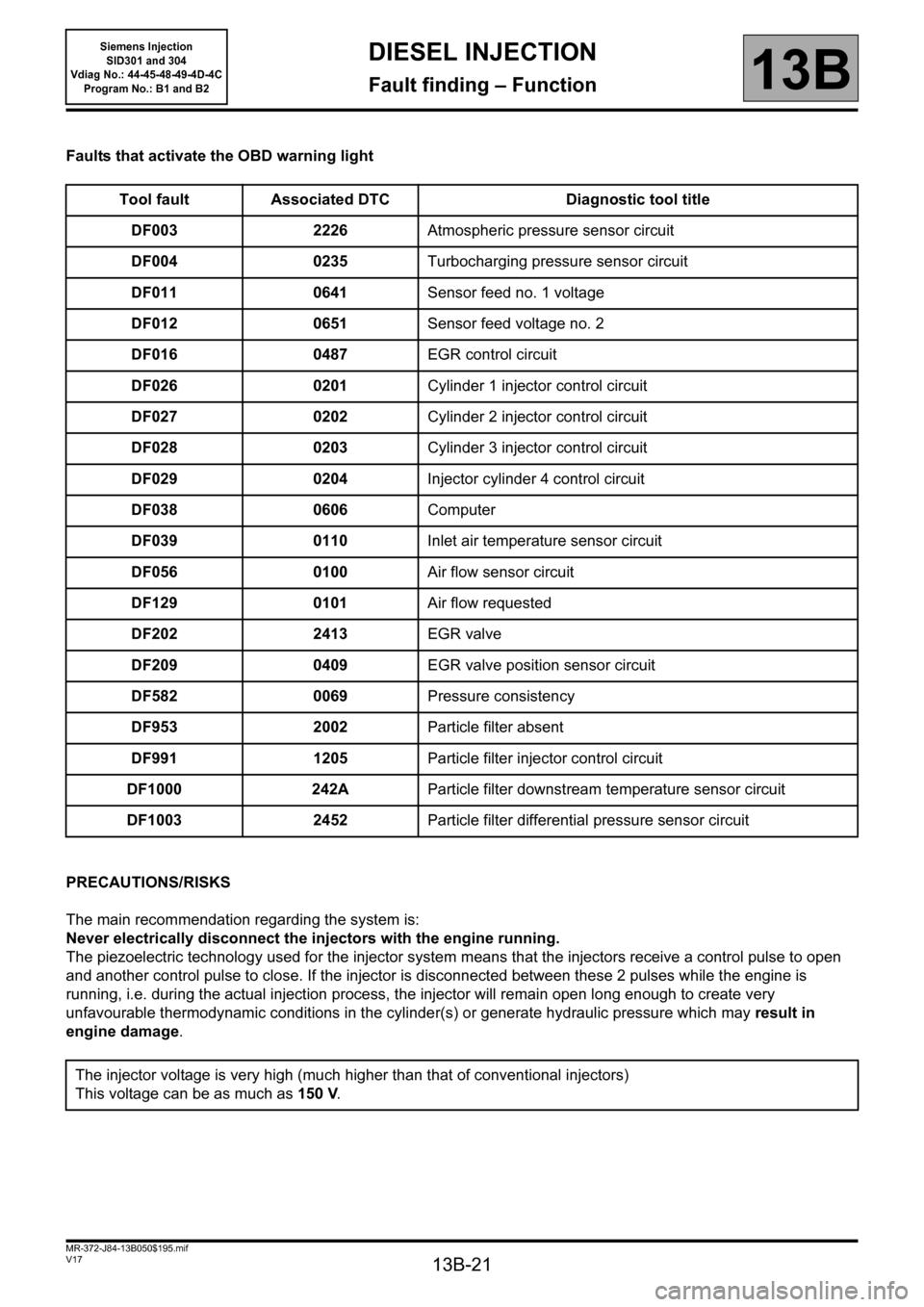
13B-21
MR-372-J84-13B050$195.mif
V17
Siemens Injection
SID301 and 304
Vdiag No.: 44-45-48-49-4D-4C
Program No.: B1 and B2DIESEL INJECTION
Fault finding – Function13B
Faults that activate the OBD warning light
PRECAUTIONS/RISKS
The main recommendation regarding the system is:
Never electrically disconnect the injectors with the engine running.
The piezoelectric technology used for the injector system means that the injectors receive a control pulse to open
and another control pulse to close. If the injector is disconnected between these 2 pulses while the engine is
running, i.e. during the actual injection process, the injector will remain open long enough to create very
unfavourable thermodynamic conditions in the cylinder(s) or generate hydraulic pressure which may result in
engine damage. Tool fault Associated DTC Diagnostic tool title
DF003 2226Atmospheric pressure sensor circuit
DF004 0235Turbocharging pressure sensor circuit
DF011 0641Sensor feed no. 1 voltage
DF012 0651Sensor feed voltage no. 2
DF016 0487EGR control circuit
DF026 0201Cylinder 1 injector control circuit
DF027 0202Cylinder 2 injector control circuit
DF028 0203Cylinder 3 injector control circuit
DF029 0204Injector cylinder 4 control circuit
DF038 0606Computer
DF039 0110Inlet air temperature sensor circuit
DF056 0100Air flow sensor circuit
DF129 0101Air flow requested
DF202 2413EGR valve
DF209 0409EGR valve position sensor circuit
DF582 0069Pressure consistency
DF953 2002Particle filter absent
DF991 1205Particle filter injector control circuit
DF1000 242AParticle filter downstream temperature sensor circuit
DF1003 2452Particle filter differential pressure sensor circuit
The injector voltage is very high (much higher than that of conventional injectors)
This voltage can be as much as 150 V.
Page 22 of 329
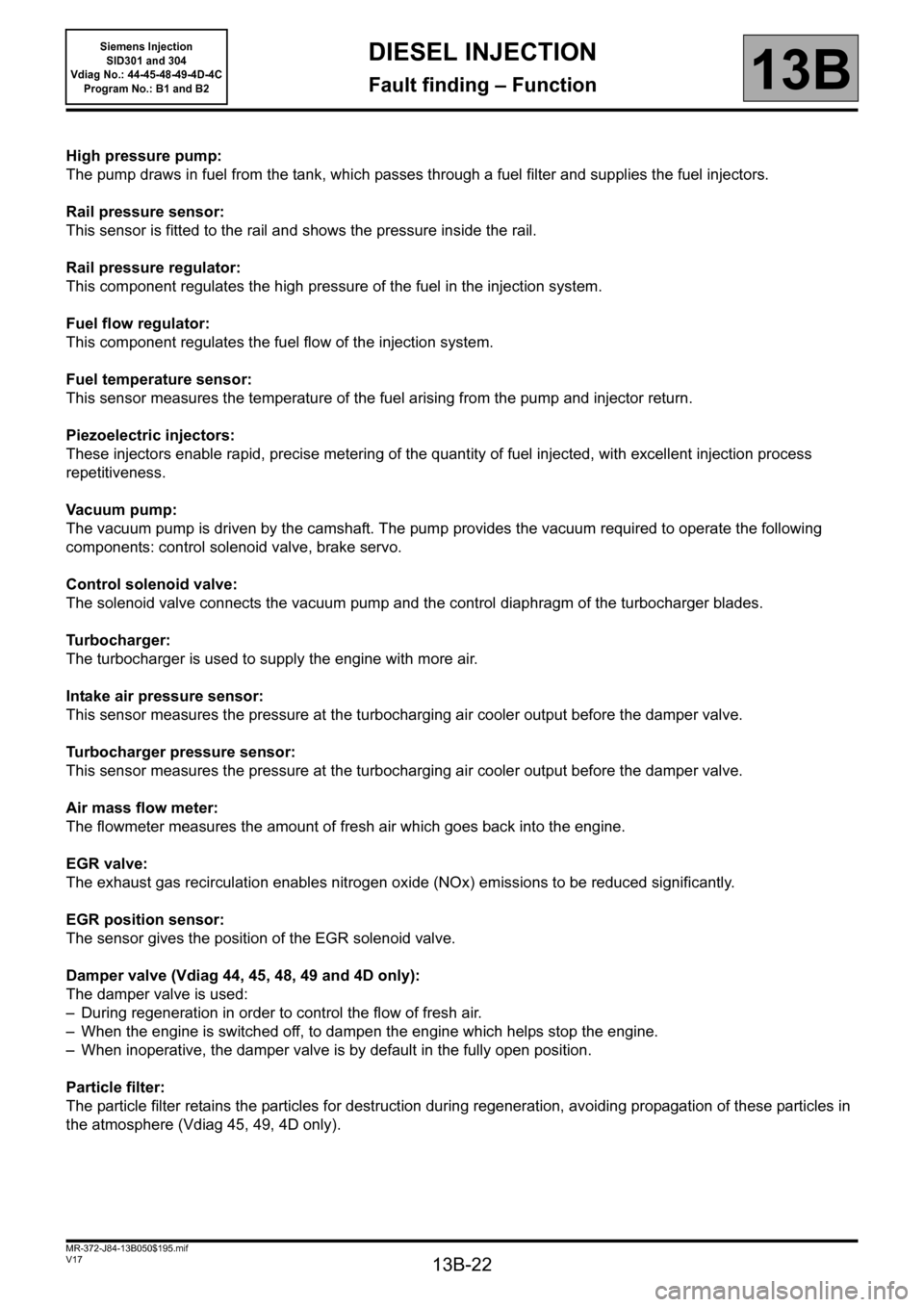
13B-22
MR-372-J84-13B050$195.mif
V17
Siemens Injection
SID301 and 304
Vdiag No.: 44-45-48-49-4D-4C
Program No.: B1 and B2DIESEL INJECTION
Fault finding – Function13B
High pressure pump:
The pump draws in fuel from the tank, which passes through a fuel filter and supplies the fuel injectors.
Rail pressure sensor:
This sensor is fitted to the rail and shows the pressure inside the rail.
Rail pressure regulator:
This component regulates the high pressure of the fuel in the injection system.
Fuel flow regulator:
This component regulates the fuel flow of the injection system.
Fuel temperature sensor:
This sensor measures the temperature of the fuel arising from the pump and injector return.
Piezoelectric injectors:
These injectors enable rapid, precise metering of the quantity of fuel injected, with excellent injection process
repetitiveness.
Vacuum pump:
The vacuum pump is driven by the camshaft. The pump provides the vacuum required to operate the following
components: control solenoid valve, brake servo.
Control solenoid valve:
The solenoid valve connects the vacuum pump and the control diaphragm of the turbocharger blades.
Turbocharger:
The turbocharger is used to supply the engine with more air.
Intake air pressure sensor:
This sensor measures the pressure at the turbocharging air cooler output before the damper valve.
Turbocharger pressure sensor:
This sensor measures the pressure at the turbocharging air cooler output before the damper valve.
Air mass flow meter:
The flowmeter measures the amount of fresh air which goes back into the engine.
EGR valve:
The exhaust gas recirculation enables nitrogen oxide (NOx) emissions to be reduced significantly.
EGR position sensor:
The sensor gives the position of the EGR solenoid valve.
Damper valve (Vdiag 44, 45, 48, 49 and 4D only):
The damper valve is used:
– During regeneration in order to control the flow of fresh air.
– When the engine is switched off, to dampen the engine which helps stop the engine.
– When inoperative, the damper valve is by default in the fully open position.
Particle filter:
The particle filter retains the particles for destruction during regeneration, avoiding propagation of these particles in
the atmosphere (Vdiag 45, 49, 4D only).
Page 24 of 329
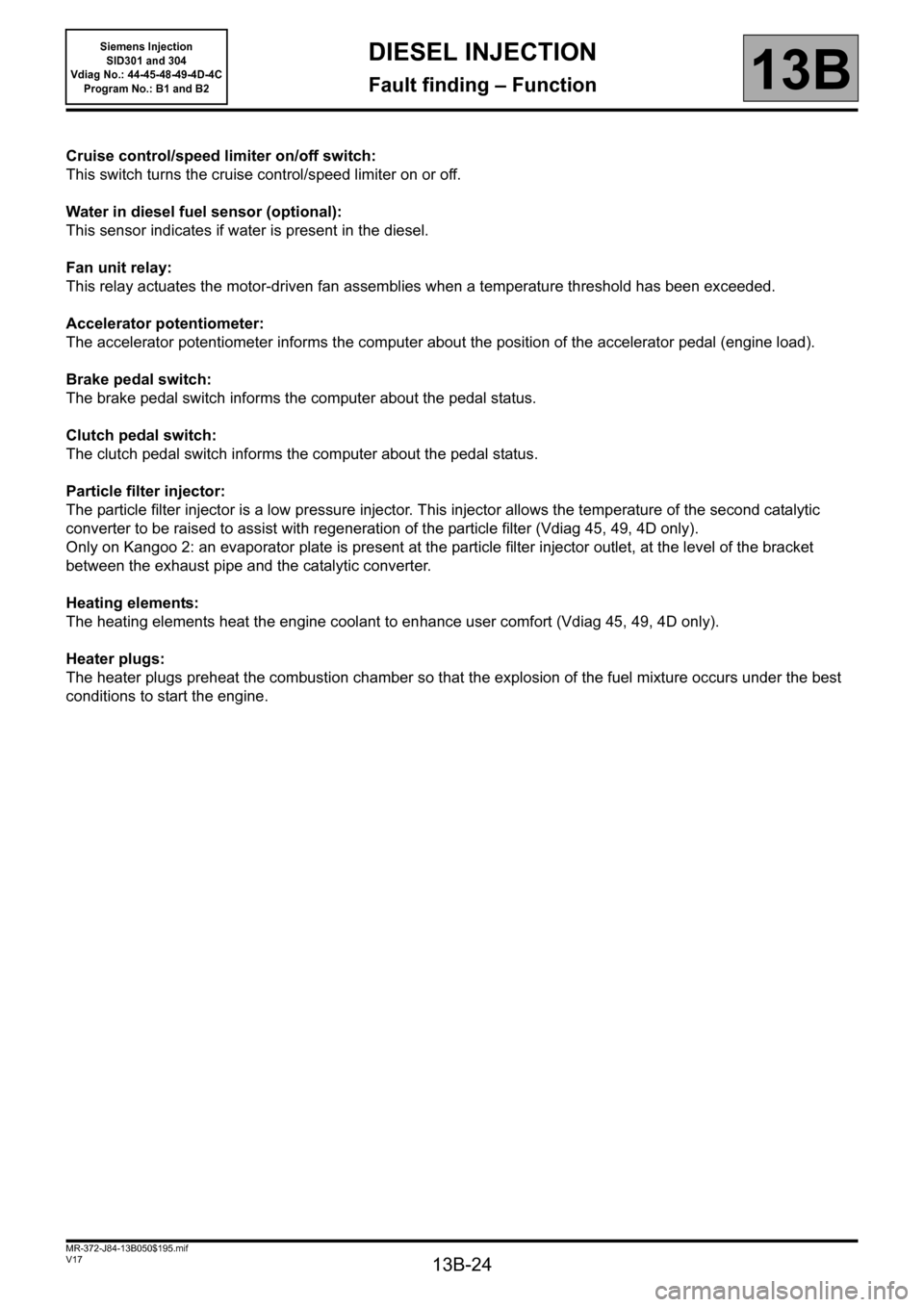
13B-24
MR-372-J84-13B050$195.mif
V17
Siemens Injection
SID301 and 304
Vdiag No.: 44-45-48-49-4D-4C
Program No.: B1 and B2DIESEL INJECTION
Fault finding – Function13B
Cruise control/speed limiter on/off switch:
This switch turns the cruise control/speed limiter on or off.
Water in diesel fuel sensor (optional):
This sensor indicates if water is present in the diesel.
Fan unit relay:
This relay actuates the motor-driven fan assemblies when a temperature threshold has been exceeded.
Accelerator potentiometer:
The accelerator potentiometer informs the computer about the position of the accelerator pedal (engine load).
Brake pedal switch:
The brake pedal switch informs the computer about the pedal status.
Clutch pedal switch:
The clutch pedal switch informs the computer about the pedal status.
Particle filter injector:
The particle filter injector is a low pressure injector. This injector allows the temperature of the second catalytic
converter to be raised to assist with regeneration of the particle filter (Vdiag 45, 49, 4D only).
Only on Kangoo 2: an evaporator plate is present at the particle filter injector outlet, at the level of the bracket
between the exhaust pipe and the catalytic converter.
Heating elements:
The heating elements heat the engine coolant to enhance user comfort (Vdiag 45, 49, 4D only).
Heater plugs:
The heater plugs preheat the combustion chamber so that the explosion of the fuel mixture occurs under the best
conditions to start the engine.